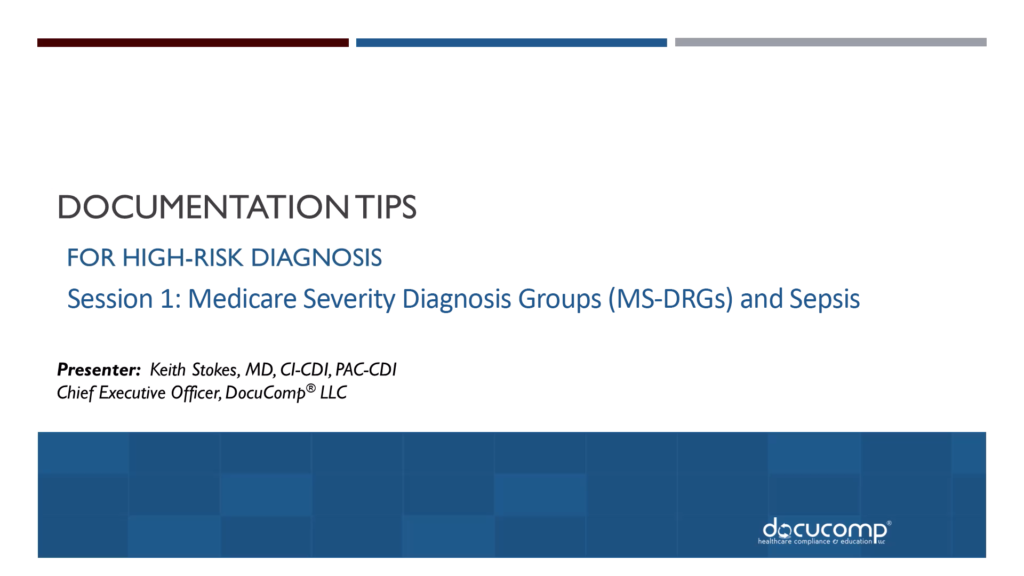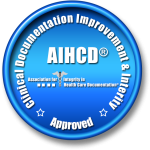Clinical Documentation Tips for High-Risk Diagnosis
Session 1: Medicare Severity Diagnosis Groups (MS-DRGs) and Sepsis
Created by Dr. Keith Stokes
- Last updated 8/20/2024
- English
Clinical Documentation Tips for High-Risk Diagnosis - Session 1
Introduction:
The “Clinical Documentation Tips for High-Risk Diagnosis” series, led by Dr. Keith Stokes, provides healthcare professionals with crucial guidance on accurately documenting high-risk conditions. This course equips clinicians with the tools to improve patient care and ensure compliance with the latest medical coding and documentation standards.
What you'll learn
- The role of Medicare Severity Diagnosis Related Groups (MS-DRGs) in hospital reimbursement and how major comorbidities (MCCs) and complications/comorbidities (CCs) affect payment.
- Key differences between MS-DRGs and APR-DRGs, and their impact on patient populations, particularly in Medicare and Medicaid cases.
- How accurate documentation of high-risk diagnoses, such as acute kidney injury and myocardial infarction, supports proper coding within the MS-DRG framework.
- The criteria used by Medicare (Sepsis-2) and commercial payers (Sepsis-3) to define and diagnose sepsis, and the significance of linking sepsis to infections and organ dysfunctions.
- Common documentation errors related to sepsis that lead to payer denials, and strategies for ensuring sepsis documentation meets clinical and coding requirements.
- ...and so much more!
Features:
Comprehensive breakdown of MS-DRG reimbursement methodologies and their application to high-risk diagnoses.
In-depth focus on the proper documentation of sepsis, including criteria used by Medicare and commercial payers.
Real-world examples of high-risk diagnoses and documentation pitfalls to avoid payer denials.
Access to on-demand video content, allowing for flexible learning at your own pace.
Who is This Course For?
This session is ideal for healthcare providers, including physicians, clinical documentation specialists, and coding professionals, who are involved in documenting high-risk diagnoses. It is also valuable for hospital administrators and quality assurance teams looking to improve documentation practices, minimize payer denials, and ensure accurate reimbursement through the MS-DRG system.
Description
Session 1 of the “Clinical Documentation Tips for High-Risk Diagnosis” course, presented by Dr. Keith Stokes, focuses on the importance of precise documentation for high-risk diagnoses that directly influence hospital reimbursement and quality measures. The session introduces key diagnostic categories, including sepsis, acute kidney injury, respiratory failure, and myocardial infarction, and explains how conditions like these impact Diagnosis Related Groups (DRGs). Additionally, the session highlights the critical role of consistent and accurate documentation in reflecting the severity of a patient’s condition, ensuring that secondary diagnoses are properly reported and linked to patient outcomes.
Special attention is given to the documentation of sepsis, a high-risk diagnosis that is frequently subject to clinical validation denials. Dr. Stokes explains the differing criteria used by Medicare (Sepsis-2) and commercial payers (Sepsis-3), emphasizing the importance of linking sepsis to underlying infections and organ dysfunctions. He highlights common pitfalls in sepsis documentation, such as failure to establish a clear connection between the diagnosis and related conditions, which can lead to reimbursement denials. The session underscores the need for precise and timely documentation to ensure sepsis is accurately reflected in patient records, particularly in cases where short hospital stays may trigger audits.
Course Content

This Course Includes:
Who Should Enroll?
Our program is ideal for:
- Healthcare Administrators
- Billing and Coding Professionals
- Case Managers
- Clinical Staff involved in patient care management

A total of .5 CEUs will be awarded by the Association for Integrity in Health Care Documentation .
Note: You will receive a downloadable Certificate of Completion from the AIHCD upon successfully completing the session.
We’ve partnered with CMEfy to support busy clinicians in their reflective learning journeys, where meaningful reflections may unlock pathways to continuing education, at no additional charge. Learn more: about.cmefy.com/for-learners

